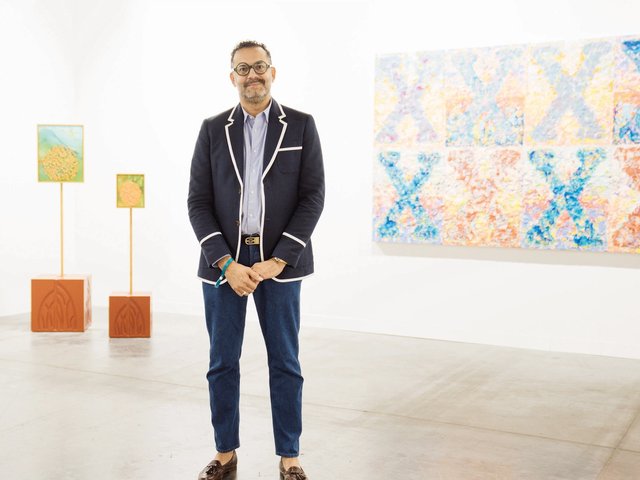Art fairs follow money. The arrival of Art Basel in Miami Beach this month (5-8 December)—its inauguration postponed by a year following 11 September—gives the world’s top fair for modern and contemporary art a platform in North America. The organisers are banking on the prestige of the Art Basel brand to attract buyers from North and South America alike. But they are also hoping to tap into local spending power. By some estimates, one fourth of the world’s wealth has a residence in Miami and the potential collecting base is diverse. It includes established buyers of contemporary art such as the Rubells, whose move to Miami from New York in 1998 is credited by some with kickstarting the city’s emerging gallery scene (see facing page), as well as the wealthy Cuban and South American emigrés who have made their home in Miami.
In the three decades since Miami’s Cubans first arrived, they have risen to the top of South Florida’s business and governmental agencies. They are the power base here. The fair’s organising committee has taken demographics into account: of the 150 galleries taking part, 12 are Latin American (two from Buenos Aires, five from São Paulo, four from Mexico City and one from San José de Costa Rica). Of these, only two attend the fair’s annual Swiss edition.
Art Basel director, Samuel Keller, says Art Basel Miami Beach, “will be one of the best art fairs in the world from the outset,” but it remains to be seen whether Miami can sustain an international fair of this calibre.
The annual Miami Art Fair every January, now in its 13th year, is well attended. But that fair deals in the mid range and has, in some years, not been vetted as carefully as it could have been.
However the sales go, Art Basel Miami Beach will bring the art world to the city in full force and a range of events and exhibitions have been planned to capitalise on this.
At the TownHouse Hotel is scopeMiami, an alternative fair with 30 international dealers in contemporary art, each exhibiting the work of one artist (for information: www.scope-art.com). The event follows scopeNew York held at the Gershwin Hotel last May which reported sales of $180,000.
Local dealers are also hoping for a ripple effect on the city’s galleries. There have been galleries in Miami for the better part of three decades, but it is only in the 1990s that the scene started gathering momentum. Speaking to The Art Newspaper, Don Rubell says, “Miami today resembles early 1990s London. There’s a lot of excitement: a large number of artists now live here; things are being done more critically, and we seem to have more collectors for contemporary art than London ever did.” A show of work belonging to another prominent collector, Martin Z. Margulies, is at the Art Museum at Florida International University, until 8 December.
While many galleries cater exclusively to local tastes, four have secured a stand at Art Basel Miami Beach: Ambrosino Gallery, Diana Lowenstein Fine Art, Fredric Snitzer Gallery, and Bernice Steinbaum Gallery.
Galleries in the city are spread out across several areas. The Design District, developed by real estate entrepeneur and contemporary art collector Craig Robins, plays home to a number of them, including Bernice Steinbaum, where the work of Chinese-American painter Hung Liu, who transforms photos of turn-of-the-century China into multi-panelled painting, is on show (until 4 January) while Kevin Bruk is hosting a group exhibition of painters, rather inauspiciously titled “Everybody Knows This is Nowhere,” (5 December-8 February) and comprising six emerging painters, shown alongside works by old master Ed Ruscha and recent Documenta inclusion Fabian Marcaccio.
Further north, Ambrosino Gallery is across the street from the Museum of Contemporary Art (MOCA). Ambrosino shows American and South American artists and is staging a group show of them on its stand at Art Basel as well as in its gallery space. South of downtown, at the edge of Coral Gables, is the warehouse that houses Fredric Snitzer and Diana Lowenstein. On view at Mr Snitzer’s gallery are paintings by young Miami artist, Hernan Bas (6-30 December) which are described by the gallery as being about the futility of love. In the gallery’s project room is an installation by New York artist, David Humphrey, while Diana Lowenstein is showing new work by Mauro Machado (6-31 December). Machado, who is an established artist in his native Argentina, makes work that bridges art and science: photographs of cultures grown from samples of his own saliva.
Speaking to The Art Newspaper, Mr Snitzer says, “I’ve been in Miami for 25 years; when I came, I was an artist, and found it somewhat dismal for the first few years. Now, everything has changed. Young artists have a nurturing environment, and there is huge interest on the part of museums.”
Mr Snitzer is not alone in pointing to the critical role museum support for young, local artists has played in the evolution of the city’s art market. Two of these museums—MOCA in North Miami and the Miami Art Museum—were established as recently as 1996. Since opening, both have staged regular shows of local artists.
Originally appeared in The Art Newspaper as 'Art Basel Miami Beach'


